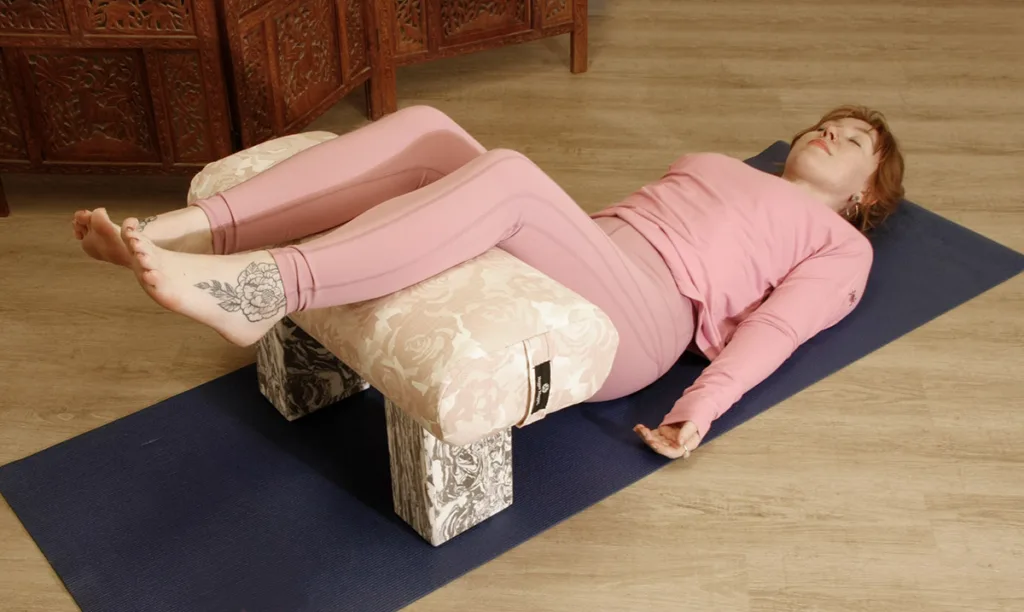
From the outside, Restorative Yoga and Yin Yoga look pretty similar. Both involve passive poses, on the floor. Both styles involve liberal use of yoga props—Yoga Blocks, Yoga Bolsters, Yoga Blankets and Yoga Straps. But despite the seeming similarities, both the intentions behind them, and the felt experiences of the two practices, are very different. If you‘d like to make an informed choice between Restorative Yoga and Yin Yoga, which one is best for you in a given situation?
The answer, as with so many questions about yoga practice is: it depends.
Restorative Yoga and Yin Yoga: The Similarities
If you’re looking for a slower, quieter yoga practice to decompress from a busy life, both Restorative Yoga and Yin Yoga can provide a still counterpoint. In both yoga styles, we hold poses for a longer time, from a minute to five minutes or more. (In Restorative Yoga, we can comfortably hold poses for as long as 20 minutes!) Both styles use the support of yoga props to allow you to stay longer in the pose, and to regulate the sensation you feel. Restorative Yoga and Yin Yoga both aim to calm the mind and body, and emphasize a gentle approach.
How Do Restorative Yoga and Yin Yoga Differ?
There are many differences between the two styles. The first is the intention behind each practice. In Restorative Yoga, the purpose is to down-regulate your nervous system, and to shift you into a parasympathetic (rest-and-digest) state. Yin Yoga’s intention is to access deep connective tissue, such as fascia, ligaments and tendons. Restorative yoga aims to create a sense of opening, with little to no stretching sensation. While Yin Yoga emphasizes a gradual release into each pose, practitioners are connect mentally and emotionally with evolving stretching sensations.
Restorative Yoga: Benefits and Contraindications
Restorative Yoga is generally considered to be safe for anyone, even for people with injuries. Here are some of the benefits:
- Calms the body and mind.
- Soothes anxiety.
- Shifts the autonomic nervous system from fight-or-flight to rest-and-digest.
- Releases muscular tension.
- Boosts the immune system.
- Supports better sleep.
- Promotes deep rest.
There really aren’t any contraindications for practicing Restorative Yoga. The only one I can think of is this: People experiencing depression might want to focus on the supine poses rather than the supported forward-bending poses. Forward bending tends to promote inward focus, which may or may not be a good idea for people experiencing depression.
Yin Yoga: Benefits and Contraindications
Here are some of the benefits of Yin Yoga:
- Increases circulation by relaxing soft tissue.
- Calms the mind and body because of the slower pace.
- Attention to subtle body sensation fosters concentration.
- Releases tension in the fascia.
- Improves joint mobility.
- Brings balance to the organs through meridian stimulation. The theory behind this is that the meridians reside in the fascial layer of the body. According to the practice, longer holds take us deeper than the muscular layer of the body, into the connective tissues. This influences the meridian system.
Opinions abound about whether Yin Yoga is contraindicated in certain cases. Some proponents contend that the purpose is to stress, and not to stretch, connective tissues. Others emphasize the stretching aspect. Opponents of Yin Yoga caution that practitioners who are hypermobile, pregnant, or who have osteoporosis should not practice Yin Yoga. If you’re interested in practicing Yin Yoga, it might be good to explore these opposing opinions to determine whether the practice is right for you.
Here are generally, but not universally, accepted contraindications:
- Those with recent or ongoing back, neck, sacroiliac (SI) joint or hip injury should avoid or proceed with caution.
- Ligaments, particularly those around the hip joints, are already more flexible during pregnancy because of the hormone relaxin. Most of Yin Yoga’s poses emphasize lower-body stretching, so pregnant people should practice with care.
- Hypermobile people generally don’t need to increase joint mobility. As a person born with a hypermobile body, I enjoy the long holds and quiet of Yin Yoga. But I practice for a minimum of sensation. My body doesn’t need to be more flexible, so when I practice passive poses with longer holds, I stay well within my comfortable range of motion instead of pushing my “edge.”
- People with osteoporosis should proceed with caution. Yin Yoga emphasizes lots of seated forward-bending poses, which could exacerbate the kyphotic thoracic curve.
Again, I encourage you to look further into Yin Yoga. Here’s a website that goes more deeply into cautions for Yin Yoga. This website gives a different point of view.
Practicing Restorative Yoga and Yin Yoga
Both Restorative Yoga and Yin Yoga encourage practitioners to move slowly and with care. Restorative Yoga poses are designed to promote opening, with minimal sensation, rather than stretching. So it’s important to set yourself up with lots of yoga props so that all your joints are supported. While there will be some stretching sensation in Yin Yoga, teachers urge students to move slowly and to not push their edge. If you’re going to practice either style of yoga, it’s wise to practice with an experienced teacher who can show you how to prop your poses for maximum benefit.
These two types of yoga practice don’t have to be mutually exclusive. You can practice Yin Yoga when you feel that your body would like a soothing stretch. And you can practice Restorative Yoga when your nervous system feels frazzled. Pay attention to the aftereffects of each practice, so that you can make informed choices about which style to practice at what time. In either case, be sure to give yourself a nice, long Savasana (Relaxation Pose).
